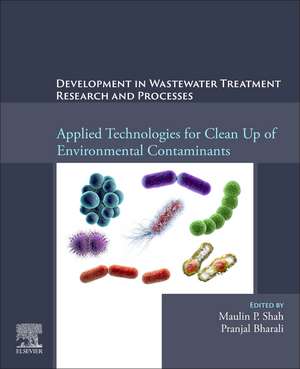Development in Waste Water Treatment Research and Processes: Applied Technologies for Clean Up of Environmental Contaminants
Editat de Maulin P. Shahen Limba Engleză Paperback – 5 noi 2024
Including coverage of key subjects such as management of waste, energy generation, restoration processes, water treatment processes, co-metabolism, and nutrient recycling as well as emerging advances in environmental microbial biotechnology, green nanotechnology, metagenomic and proteomic strategies, DNA microarray, and biosensor-based technologies, this book provides potential implications for environmental management.
- Includes microbially driven sequestration of environmental contaminants such as xenobiotics, heavy metals, petroleum-based pollutants, and other micropollutants
- Overviews recent discoveries in geomicrobiology, aeromicrobiology, biocontrol, complex plant-microbe relationship, and microbial process energetics
- Reviews promising ecologically benign technologies, such as waste valorization, biomining, the use of biosolids and microbial metabolites
Preț: 1041.03 lei
Preț vechi: 1367.21 lei
-24% Nou
Puncte Express: 1562
Preț estimativ în valută:
199.20€ • 217.06$ • 167.86£
199.20€ • 217.06$ • 167.86£
Carte tipărită la comandă
Livrare economică 16-30 aprilie
Preluare comenzi: 021 569.72.76
Specificații
ISBN-13: 9780443136153
ISBN-10: 0443136157
Pagini: 450
Dimensiuni: 191 x 235 mm
Greutate: 0.45 kg
Editura: ELSEVIER SCIENCE
ISBN-10: 0443136157
Pagini: 450
Dimensiuni: 191 x 235 mm
Greutate: 0.45 kg
Editura: ELSEVIER SCIENCE
Cuprins
SECTION 1 Microbial-based management of environmental pollutants
1. Microbes in sequestration of micropollutants including microplastics
2. Microbial surfactants: The ecofriendly tools for sustainable bioremediation of petroleum and organic contaminants for environmental safety
3. Insecticides: Current status, properties, and the biological degradation strategies
4. Microplastics contamination in agricultural ecosystems: Challenges and sustainable approaches for green environment
5. Pesticides and their degradation: A microbiological perspective
6. Current status and perspectives of municipal wastewater treatment using microalgal systems
7. Biotransformation of environmental pollutants: Exploring halophilic microbial interventions
SECTION 2 Microbial-based management of resource
8. Microbee-Mineral interface (MMI): Study and assessment of abiotic biomolecules from molecular to macroscopic scale
9. Microbes in energy generation
10. Microbial fuel cell (MFC) in bioremediation, wastewater treatment, resource recovery, and bioelectricity generation: Advances, challenges, and, opportunities
11. Microbes in water treatment process
12. The role of microorganisms in energy generation
13. Microbial-based strategies for remediation of agricultural wastes
14. Microbial electrochemical technologies for the valorization of food wastes: A comprehensive review
15. Prospects of large-scale microalgae culture using industrial wastewater for biofuel production
16. Microbes in the biomining process: A nanobiotechnological perspective
SECTION 3 Rhizospheric ecology of contaminated environment
17. Role of rhizobacteria in rapid growth and phytopathogenic mitigation of Arecales
SECTION 4 Role of biofilms in environment pollution control
18. Role of biofilms in control of heavy metal pollution and subsequent control of algal blooms
19. An overview on role of biofilms in environment pollution remediation
20. Microbial biofilm in bioremediation of environmental contaminants and wastewater treatment: Challenges and opportunities
SECTION 5 Microbes as remediating agent
21. Degradation of crude oil in bioreactors by oleophilic bacteria
22. Microbes in bioremediation of heavy metals
23. Microbes in bioremediation of pesticides
24. Microbes in bioremediation of petroleum pollutants
25. Microbes in xenobiotics biodegradation
SECTION 6 Energetics of microbial processes in the polluted environment
26. An insight into the ecological toxicity triggered by anthropogenically driven heavy metal micropollutants on biotic community
SECTION 7 DNA microarray applications in environmental microbiology
27. Metagenomic and proteomic approach for bioremediation of environmental pollutants
28. Metagenomics of River Ganga: A potential approach in bioremediation
29. Strategies and methods of OMICS-based approaches in microbial environmental bioremediation
SECTION 8 Microbial biosensors for environmental monitoring
30. Microbial biosensors in environmental monitoring
31. Biosensors in heavy metal and metalloid detection: Genetic, cellular, and nanomaterial applications
1. Microbes in sequestration of micropollutants including microplastics
2. Microbial surfactants: The ecofriendly tools for sustainable bioremediation of petroleum and organic contaminants for environmental safety
3. Insecticides: Current status, properties, and the biological degradation strategies
4. Microplastics contamination in agricultural ecosystems: Challenges and sustainable approaches for green environment
5. Pesticides and their degradation: A microbiological perspective
6. Current status and perspectives of municipal wastewater treatment using microalgal systems
7. Biotransformation of environmental pollutants: Exploring halophilic microbial interventions
SECTION 2 Microbial-based management of resource
8. Microbee-Mineral interface (MMI): Study and assessment of abiotic biomolecules from molecular to macroscopic scale
9. Microbes in energy generation
10. Microbial fuel cell (MFC) in bioremediation, wastewater treatment, resource recovery, and bioelectricity generation: Advances, challenges, and, opportunities
11. Microbes in water treatment process
12. The role of microorganisms in energy generation
13. Microbial-based strategies for remediation of agricultural wastes
14. Microbial electrochemical technologies for the valorization of food wastes: A comprehensive review
15. Prospects of large-scale microalgae culture using industrial wastewater for biofuel production
16. Microbes in the biomining process: A nanobiotechnological perspective
SECTION 3 Rhizospheric ecology of contaminated environment
17. Role of rhizobacteria in rapid growth and phytopathogenic mitigation of Arecales
SECTION 4 Role of biofilms in environment pollution control
18. Role of biofilms in control of heavy metal pollution and subsequent control of algal blooms
19. An overview on role of biofilms in environment pollution remediation
20. Microbial biofilm in bioremediation of environmental contaminants and wastewater treatment: Challenges and opportunities
SECTION 5 Microbes as remediating agent
21. Degradation of crude oil in bioreactors by oleophilic bacteria
22. Microbes in bioremediation of heavy metals
23. Microbes in bioremediation of pesticides
24. Microbes in bioremediation of petroleum pollutants
25. Microbes in xenobiotics biodegradation
SECTION 6 Energetics of microbial processes in the polluted environment
26. An insight into the ecological toxicity triggered by anthropogenically driven heavy metal micropollutants on biotic community
SECTION 7 DNA microarray applications in environmental microbiology
27. Metagenomic and proteomic approach for bioremediation of environmental pollutants
28. Metagenomics of River Ganga: A potential approach in bioremediation
29. Strategies and methods of OMICS-based approaches in microbial environmental bioremediation
SECTION 8 Microbial biosensors for environmental monitoring
30. Microbial biosensors in environmental monitoring
31. Biosensors in heavy metal and metalloid detection: Genetic, cellular, and nanomaterial applications
